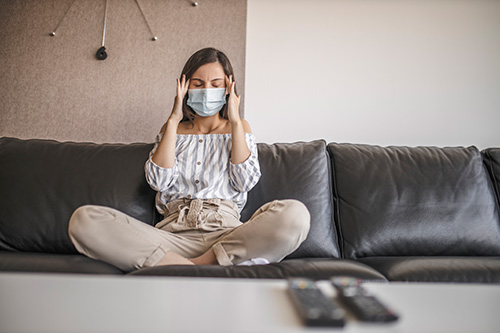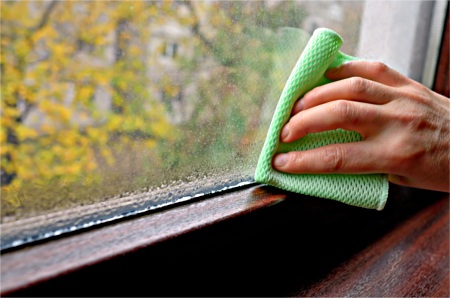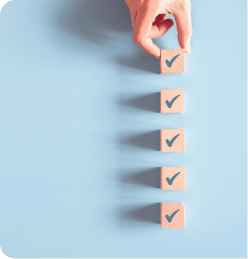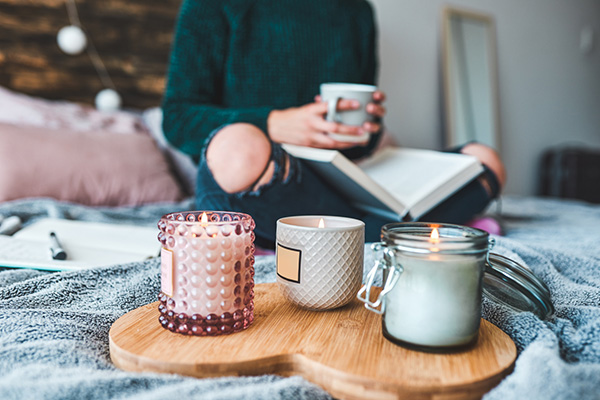Authored by Dr. Sarika Arora, MD
When Dr. Jill Crista, ND investigated her patients’ mysterious chronic symptoms, she was shocked to discover mold was the cause. What’s more, she realized her own health was harmed from mold exposure in her home too. Here, Dr. Sarika Arora, MD talks with Dr. Jill about her experiences – as both a mold expert and as a patient – to find out how every woman can protect herself from the dangers of mold.

Dr. Arora: Why should mold be such a concern to women?
Dr. Jill: Mold not only creates spores that cause respiratory issues, it also produces toxic substances known as mycotoxins that can lead to chronic illnesses. Once mold starts growing, it secretes mycotoxins to kill other mold in competition for dark, stagnant air and food sources. Unfortunately, mycotoxins also harm other living beings in the house by infecting the indoor air. As women, we are very very good sponges to absorb dangerous mycotoxins. Mycotoxins are fat soluble toxins and we tend to have a higher body fat percentage than men. When a home or work environment has a mold outbreak, it’s very common that the women start to get sick before the men.
Dr. Arora: What are the symptoms of mold poisoning?
Dr. Jill: The most common symptoms that I see in my patients are:
- Feeling tired but restless or nervous (like an inability to access inner quietness)
- Increased allergies and chemical sensitivities
- Irritable bowel syndrome
- Irregular heartbeat
- Headaches and migraines
- Rashes
- Menstrual cycle changes and fertility issues
- Sleep issues
Sometimes, my patients will suffer from chronic sinusitis. But that’s not necessarily the case if the spores aren’t floating around, such as when building materials trap spores. If you have frequent colds and flus, you might not really recover very quickly because mold creates an immune deficiency. Mycotoxins are potent nerve toxins. You’ll see a lot of cognitive impairment and that definitely affected me personally when it happened in my house.
Dr. Arora: It hits on so many different systems – neurological, immune, liver, detox.
Dr. Jill: Yes, with brain fog – and so many other symptoms – it’s really hard to understand what is going on with your body when it happens to you. The classic story I hear is someone who didn’t have health problems takes a new job or moves into a different house. And low grade mysterious symptoms start happening. It’s often very easy to just discount the new symptoms as a hormonal change. And it may have been a pre-scheduled hormone change that was going to happen. But it may have been hastened by toxins from mold getting into the body and invading how it functions normally.
Dr. Arora: Can you discuss the physical dangers of mold?
Dr. Jill: Any mold that’s growing indoors is not good. What’s more, toxins can seep through all kinds of materials like vinyl flooring, drywall and insulation. Many of my patients didn’t even know mold was in their houses because it was hidden behind drywall or in their basements. However, the toxins were aerating through their HVAC system, spreading it everywhere and soaking into their furniture, into their paint, into all their textiles. We missed the mold in our house because mold toxins don’t have a smell. The musty smells that we associate with mold are more the chemicals the mold secretes as part of their daily living. The area where we had mold in our home was absorbent enough that it was absorbing the smell of all of the toxins.
I definitely recommend if you are sensitive to mold, have a genetic disposition to mold reactions, or have been sensitized or have any pre-existing detox or immune-neurological issues, don’t even let the mildew hang out in your shower. While it doesn’t have mycotoxins, it does contain other harmful chemicals like alcohols and formaldehydes.
Dr. Arora: What do different molds look like? How do you find mold in your home?
Dr. Jill: One of the common molds in houses is cladosporium, which is that greenish mold that grows around window sills. It’s really easy to clean up with a toothbrush and vinegar, but use gloves and a mask because it will dump volatile organic compounds (VOCs) as it dies.
An easy way to find molds in a basement or damp environment is to take a flashlight and shine it tangentially across that building material. If it looks like there’s white dust, that’s probably aspergillus, which is the second most common indoor mold after penicillium. On plywood and OSB materials we’re putting in our homes, those two molds can get sort of a greenish fuzz but it’s not like the mold on bread – it’s not that green – it just has sort of a dusty hue to it. You can’t tell by the color of a mold what it is. You must test it.

Dr. Arora: What about air filters? Which high quality air filters do you recommend?
Dr. Jill: I recommend air filters that can work all the way down to the mycotoxin level. Mold spores themselves are about 1-3 microns in size, but spores can fragment into smaller parts that can be very inflammatory to the sinuses and lungs. They can make it further down the respiratory tract because they are only 1-2 microns in size. Mycotoxins are 0.1 microns in size. They are itty-bitty. They can get down into the deepest parts of the lungs. You can also eat them and they can also soak into the skin. So you want to make sure that you’re choosing an air filter that will deal with the mycotoxins as well.
I often recommend IQair.com for HyperHEPA filtration. Airfree.com is a good place to find the incinerator type of air filters that are good for small areas. A sanitizing purifier spits out beneficial super-charged oxygen – called ionized oxygen – which is different than ozone (which you don’t want!). I like one called Intellipure Premium Plus. An air filter isn’t a replacement for remediation. There’s no way you can filter air or open windows to keep up with the amount of mycotoxins that mold can create.
Dr. Arora: The big point here is don’t skip the remediation and just run a bunch of purifiers because that’s not going to keep up with the mold’s ability to produce toxins.
Dr. Jill: Exactly. But once you’ve remediated and during the remediation you can use an air filter to protect yourself in case of contamination. The number one thing to do if you think you’re in an environment that is hosting mold and making you sick is to get out. Don’t take anything with you when you do, because you are probably bringing the mold along with the materials. Finally, call a building biology inspector to test your home, and if necessary, find a remediation company that they know that is doing a good job.
Dr. Arora: Could you explain more about what is remediation and what are the steps of remediation?
Dr. Jill: Remediation is a complicated process to remove mold from your house. I have a guide about what to do if you have water damage on my website. By the way, OSHA estimates that 25 percent of buildings in the U.S. have had water damage to some degree. A lot of remediation companies are hesitant to remove too much material. There can be financial pressure from the homeowners not to take too much because it’s going to be expensive. If there’s insurance coverage, they may be under pressure by the insurance company to do the same thing. Here are a few ways that happens:
- “Seal and deal.” This is when the remediation company simply seals up the moldy area and paints over it. The truth is that any material that looks sick needs to go. Along with an extra clean margin on the side. If you’re mold sensitive, your body will tell you with a reaction. Trust it.
- “Spray and pray.” Many times they’ll take the drywall off and leave the wood thinking that wood is more resistant because of all its natural oils. While wood is more resistant, it can still take on mold.
- Don’t have the remediation company do your inspection. That’s a conflict of interest. The company could make your post-remediation tests look really nice. But what is happening in our area is that one in three remediations is redone. Because they didn’t remediate correctly. I really recommend if someone is concerned about mold and toxins in their office or their home that they hire a building biologist. A building biologist is trained to find mold when nobody else has been able to do it. They also know best how to take the samples.
We found two forms of toxic mold in our house. It’s been really hard but interesting to see the process of remediation – and remediating our own bodies – and it’s very similar to what I watched my patients go through.
Dr. Arora: Let’s talk about “remediating” your body. When we met at a conference, you talked about how some essential oils have been shown to reduce fungal growth and mycotoxin production and are safe to inhale long-term. What are some options?
Dr. Jill: Yes. Some essential oils are used to reduce fungal growth and some are shown to actually kill the fungus. All of the ones I’ll mention are shown to reduce mycotoxin production from indoor molds. The cool thing about this is that you can clean with them to protect yourself from mycotoxins and mold. Of course, some people are still sensitive to essential oils, so I would say it’s not an across the board recommendation. But for most people, it sure is better than using bleach. The ones that I like are:
- Cedar leaf is a broad spectrum antimicrobial that’s a lovely one to have onboard because it can not only take care of the mold but it can also take care of the bacteria.
- Thyme is another one of my favorites and it’s a very easy spice to find. For people suffering from cold symptoms, I have them boil thyme leaf in a saucepan and then take that with them wherever they are going to be in their home. With its broad-spectrum microbial properties, it can clear the sinuses and it can clear the air, reducing any mycotoxins that might be emitting from their building materials.
- Ajwain is also known as carom seeds and is added to a lot of cooking in ayurvedic tradition. It’s sort of a blend of cumin and cedar and it’s got a really great smell.
- Tea tree oil
- Rosemary
- Holy basil
- Cumin
People are sometimes afraid to combine these, but these are all plant ingredients that can be combined so don’t be afraid of experimenting. Finding the blend that smells best to them is probably the blend that they need therapeutically.
Dr. Arora: The blend that smells best to someone is the one that she needs?
Dr. Jill: Usually! In practice, I’ve found that people are attracted to smells that they need – and tastes as well. Except, I also find that people who have mold toxicity while they are toxic tend to be carb addicts. But once you start treating it, they start going toward bitters and garlic, onions and sulfur containing foods, like broccoli.

Dr. Arora: What are some lab tests that can give women and their doctors more information?
Dr. Jill: When it comes to spores, your own body can actually become a host for colonies. We all have fungus in our sinuses, but some people who’ve been exposed to a water-damaged building have biofilm “intel” sharing. When microbes find a good spot to thrive, they’ll cooperate to some degree. I think of it kind of like Mad Max! The secret code gets transferred to your own microbes in your body. And then your fungus in your sinus creates biofilm. As a result, you can leave the water damaged building or work and bring the problem with you in your sinuses. You can get a urine mycotoxin test. If you see urine mycotoxins, you can have a very high suspicion of sinus colonies creating these biofilms that lead to mycotoxins. Urine mycotoxin tests are available at Great Plains Lab and RealTime labs.
The technology for testing a building is expanding rapidly. You can test your living space for mycotoxins now. RealTime Labs has a kit. You collect dust samples from multiple sites around the space such as the tops of door jams and high picture frames, places you don’t dust regularly. You can also test a 1-inch chunk of your furnace filter if the house has been closed up for a few months. If you find mycotoxins in the dust in your living space, a building biologist then will be the best for locating the problem.
Dr. Arora: We talked about exposures – the drywall, the flooring – what are some other big exposures that women are not aware of now?
Dr. Jill: We’ve got to talk about wine. Wine tends to be very high in an indoor mycotoxin called ochratoxin. If you live in a house with mold and you start getting rashes and flushes from wine, you should really be checking with the wine company to see if it is testing for ochratoxins. There are wine companies that are more conscious of that and make sure that they’re not making wine out of grapes that have a lot of fungus on them.
Another issue is for the HGTV lover who wants to spruce up her bathroom. So many companies advertise that they’ll get out a stain. But if you do have some kind of staining of your paint or ceilings in your bathroom, that’s a problem, or bathtub covers that you put over the old bathtub. They trap moisture and try to cover tile that’s falling off and needs to be removed. You’re better off living in a house with exposed rafters that’s healthy than trying to keep it pretty and be sick from it. I get the hesitancy to really dig in and tear stuff out because it’s destructive, it’s dusty, it’s loud, it’s hard, it’s expensive. But it’s worth it.
Dr. Arora: If you could rewind 10 years and could change one lifestyle habit, what would it be?
Dr. Jill: I would say overwork. Because when I was actually sick from mold I was blaming my own Type A tendencies. I thought I was trying to do too much and experiencing symptoms because of it. For example, I would think “I’ve got brain fog – well, people who work hard get brain fog.” I used my overdrive as an excuse for a lot of the symptoms that were happening to me.
Dr Arora: If you have one single most important thing that you want women to do right now, what would it be?
Dr. Jill: As a woman, if you are getting sick from your environment, trust and advocate for yourself. I’ve learned a lot from when I’ve been blown off and my patients have been blown off by so-called experts. But you know your body better than anybody.
Trust yourself. You can learn more about Dr. Jill and her work with mold illness at drcrista.com. More information about Dr. Arora and her medical center can be found at aumhealingcenter.com.








